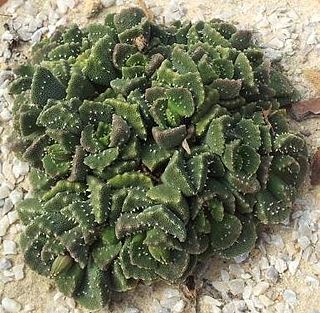
Aloinopsis is a genus of ice plants from South Africa.

In botany, succulent plants, also known as succulents, are plants with parts that are thickened, fleshy, and engorged, usually to retain water in arid climates or soil conditions. The word succulent comes from the Latin word sucus, meaning "juice" or "sap".
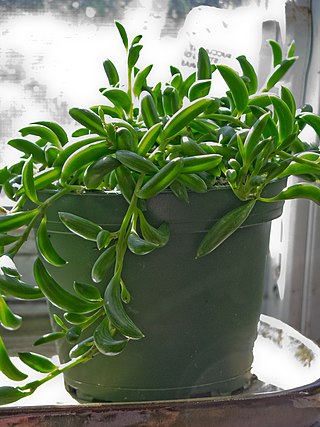
Curio radicans, syn. Senecio radicans, is a succulent houseplant that is native to Southern Africa. A member of the family Asteraceae, the asters, this species is closely related to the common string of pearls and Curio hallianus. It has multiple tendrils of glossy, banana-shaped foliage. It is commonly known as string of bananas or fishhook senecio.
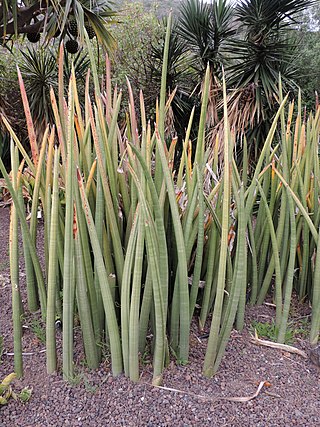
Dracaena stuckyi, synonym Sansevieria stuckyi, is a species of succulent plant native to Africa including Mozambique, Tanzania, and southern Kenya. It is a member of a group of related Dracaena including Dracaena angolensis and Dracaena pearsonii, that grow upright, cylindrical foliage and are native to dry biomes.

Cheiridopsis denticulata is a species in the genus Cheiridopsis native to South Africa. It has yellow flowers, and distinctive foliage with a narrow, upward curving shape. Commonly called "pink fingers", the leaves grow in opposite pairs and are light blue with sun exposure blushing them shades of pink and purple.

Aloinopsis malherbei is a species of succulent plant, also known as the giant jewel plant. It is native to the Cape Provinces of South Africa, especially the area around Calvinia and Loeriesfontein. The plant produces a thick tuber and produces yellow flowers. Unlike other Aloinopsis, it only has tubercles (bumps) at the leaf tips.
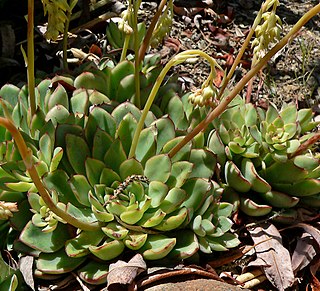
Echeveria pulidonis is a species of flowering plant in the family Crassulaceae, native to central Mexico, more specifically, Puebla and Veracruz.
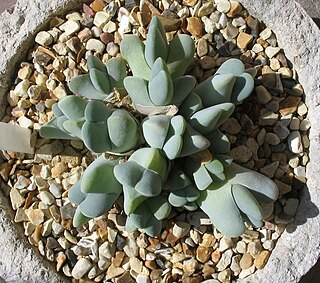
Cheiridopsis pillansii is a species of plant in the genus Cheiridopsis native to South Africa. It is a low-growing succulent with pairs of small, cushion-like leaves that are pale green to purple in color. C. pillansii, sometimes commonly called the "hoof mesemb", forms clumps up to 500 millimetres (20 in) wide.

Aloe descoingsii is a species of Aloe native to southern Madagascar. Regarded as the smallest Aloe species in the world, it generally reaches a maximum of about 3 inches (7.62 cm) across. With white spotted leaves, A. descoingsii grows via offsets in clumps and sports tiny orange flowers.
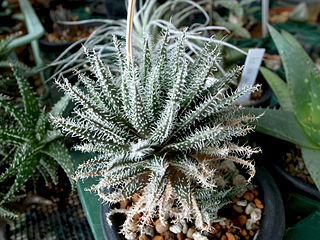
Aloe haworthioides is a species of plant in the genus Aloe native to Madagascar. This aloe is named for its leaves, which are covered with soft spines that create a resemblance to Haworthia species. A small species, it grows in stemless, clumping offsets and sports orange, highly fragrant flowers.

Haworthia mutica is a species of succulent plant native to South Africa's Cape Province. Very similar to, and often confused with, types such as Haworthia retusa, the species has blunt, triangular shaped leaves that are typically striated. In the wild it rarely offsets, though clones in cultivation may do so readily. The variety H. mutica var nigra is similar but with darker leaf color.

Haworthia chloracantha is a species of succulent plant native to the Cape Province of South Africa. H. chloracantha has typically pale yellow-green leaves and is somewhat similar to Haworthia reticulata in form, but the leaves are opaque rather than translucent. It forms prolific clusters of plants. The plant has a few subvarieties including var. denticulifera, meaning has small teeth on its leaves, and var. subglauca, which has darker foliage.

Haworthia lockwoodii is a species of succulent plant in the genus Haworthia. Native to the Cape Province of South Africa, it was named for a local magistrate.

Haworthia floribunda is a species of succulent plant in the genus Haworthia native to the Cape Province of South Africa. It grows in rosettes with dark green, lanceolate leaves that curve or twist outward. The leaves may be smooth or, in H. floribunda var. dentata, have small teeth.
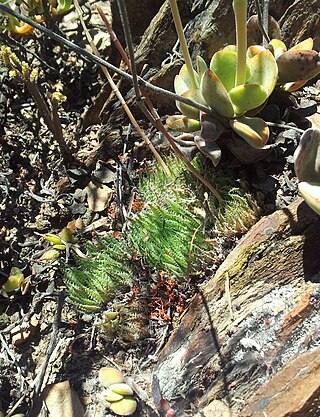
Haworthia herbacea is a species of succulent plant in the genus Haworthia native to the Cape Province of South Africa. Closely related to Haworthia reticulata, it has greenish yellow leaves with small spines. As it matures the leaves get darker green and the white spots raise. Flowers by way of a shoot and produces a large off-white flower.
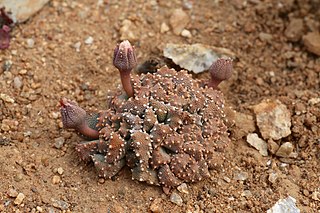
Aloinopsis luckhoffii is a species of succulent plant in the genus Aloinopsis native to South Africa. Like other Aloinopsis it grows in a rosette of leaves close to the ground. It has angular leaves that are covered by small, white tooth-like protrusions.
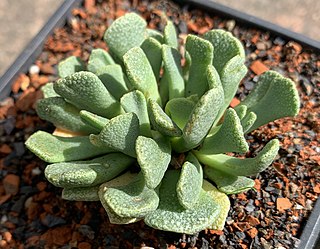
Aloinopsis spathulata is a species of succulent plant in the genus Aloinopsis native to South Africa. It has spoon-shaped green leaves patterned with tubercles, and unlike the yellow flowers of most in its genus, it has magenta to pink blooms. Able to grow in Sutherland, the coldest town in South Africa, it is particularly frost hardy.
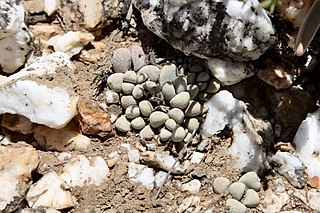
Crassula tecta is a species of succulent plant in the genus Crassula native to South Africa. Easily confused with Crassula namaquensis, this species has a compact growth habit forming clusters of round, blue-white leaves. Kept in cultivation since the 18th century, Crassula tecta is known for the beautiful patterning on its leaves and white flowers.
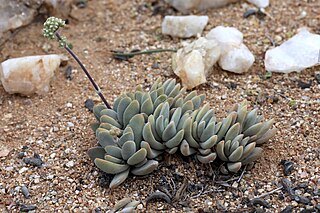
Crassula namaquensis is a species of succulent plant in the genus Crassula native to South Africa. Easily confused with some forms of Crassula tecta and Crassula sericea, this species has rounded to elongated leaves that are usually blue, covered in fine hairs, and form clumps.

Haworthia reticulata is a species of succulent plant native to the southwestern Cape Provinces of South Africa. The species has several varieties, including var. hurlingii which is the smallest at up to 1 inch (2.5 cm) wide.




















